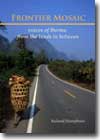| Our Publications | ||
| Books by Title | ||
| Books by Author | ||
| Books by Country | ||
| E-books | ||
| About | ||
| Orchid Press E-books | ||
| Distributed E-books | ||
| Our Bookshop | ||
| About Us | ||
| Browse Shop | ||
| How to Buy | ||
| Contact Us | ||
| WE BUY BOOKS AND LIBRARIES | ||
|
||
Book Reviews

Frontier Mosaic:
Voices of Burma from the lands in between
by Richard Humphries
2007. 200 pp., 80 colour images, 3 maps, bibliography, index, 24.5 x 17.5 cm., softcover.
ISBN-10: 974-524-092-3 $29.95
ISBN-13: 978-974-524-092-6
Tales from the Land in Between
Book review by Bertil Lintner
(Irrawaddy Magazine, November 2007)
In recent weeks, the world’s attention has focused on events in Burma. The interest in the for now failed saffron revolution was so great it pushed the news from Iraq off the front pages of America’s newspapers for the first time since the 2003 invasion.
But for decades, people living along the border areas have been brutally beaten down by the regime-mostly out of the glare of media attention.
Richard Humphries, an American who teaches at universities in Japan, has been a frequent visitor to the border conflict zones, and in this, his first book, he provides firsthand accounts of the extraordinary people he has encountered on both sides of the Thai-Burmese frontier.
Among the people whose stories are told, in their own words and in Humphries’ narrative, is a deserter who describes how he joined the army at 16, well below the official minimum age limit for Burmese soldiers. Even so, he “was one of the oldest recruits there as most were 15.”
“But, by no means is the Burmese Army the only employer of underage soldiers,” writes Humphries, who recalls meeting an 11-year-old boy serving in the Karen rebel army, because, ‘The enemy killed my parents. I am angry and don’t want to go to a refugee camp.”
Then there’s the tale of a traditional storyteller, who was harassed by authorities and arrested in 1991. After his release, he escaped to the border and ended up with the strangest of all border groups: God’s Army, which was led by two young Karen brothers, the cheroot-smoking twins, Johnny and Luther Htoo.
Their followers believed the twins possessed magical powers, were immune to bullets, and could make themselves invisible. The Htoo twins were associated with a group of militants who, in October 1999, briefly seized the Burmese embassy in Bangkok, and a few months later, occupied a hospital in the Thai town of Ratchaburi.
We also meet Nay Rayne Kyaw, now a member of the Mae Sot-based Assistance Association for Political Prisoners (AAPP), who, during the 1988 upheavals, played cat-and-mouse games with the authorities. He was twice arrested and remembers a Burmese captain who was “very fond of kicking and beating those under his care.” Having spent eight years in various prisons, Nay Rayne Kyaw was finally released and made it to Mae Sot, where he and others created the AAPP, which documents the conditions of Burma’s many political prisoners.
There are also stories of homeless migrants, struggling mothers and striving artists, whose hopes and dreams are often dashed in the “land in between,” that is, in reality, neither Burma nor Thailand, but a volatile sanctuary for homeless and impoverished people fleeing government repression.
It is not a safe place; technically people are living on Thai soil, but, lacking passports and visas, they are classified as “illegal immigrants” and can be picked up by Thai police and detained at any time. For many, the only hope is a job in one of the sweatshops on the outskirts of Mae Sot, where they are often cheated of their wages and abused in many other ways.
Mae Sot is an “ambiguous town,” writes Humphries, listed officially as having 42,000 inhabitants although the actual number may be closer to 100,000, including “migrants but also insurgents, Burmese spies, NGO workers, traders, assorted criminals and lost souls, for some of whom registering an official presence involves complications.”
Women are the unrecognized backbone of all the communities along the border, says Humphries. Without their strength, “the societies they are in would flounder.” They work in the fields, care for the children and run small, income-producing shops from their bamboo huts where they sell soft drinks, soap powder and cheroots. The women teach in ramshackle schools where “illegal” children get a simple education. But the children get no acknowledgment for their study—no diploma or certificate to prove they have gone to school. One mother lamented: “My children don’t say anything about what they want to do in the future.”
Frontier Mosaic has a very human touch, and Humphries has a deep sympathy for the people he’s met along the border. All of the book’s royalties will be donated to “the border community, especially to the Mae Tao Clinic,” a makeshift hospital founded and directed by Dr Cynthia Maung, a Karen who fled to Mae Sot after the 1988 uprising and who since then has provided health care and education to Burmese refugees and migrant workers.
[Read a review from The Japan Times] [Read a review from Mizzima News] [More Orchid Press Reviews]
PO Box 70, Trinity TB, NL, A0C 2S0, Canada
Telephone: +1 709-330-4703